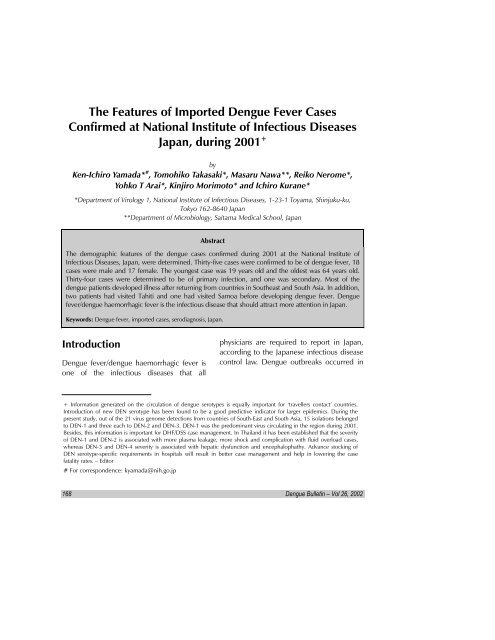Dengue Bulletin
Dengue Bulletin
Dengue Bulletin
- TAGS
- dengue
- bulletin
- 203.90.70.117
Create successful ePaper yourself
Turn your PDF publications into a flip-book with our unique Google optimized e-Paper software.
The Features of Imported <strong>Dengue</strong> Fever Cases<br />
Confirmed at National Institute of Infectious Diseases<br />
Japan, during 2001 +<br />
by<br />
Ken-Ichiro Yamada* # , Tomohiko Takasaki*, Masaru Nawa**, Reiko Nerome*,<br />
Yohko T Arai*, Kinjiro Morimoto* and Ichiro Kurane*<br />
*Department of Virology 1, National Institute of Infectious Diseases, 1-23-1 Toyama, Shinjuku-ku,<br />
Tokyo 162-8640 Japan<br />
**Department of Microbiology, Saitama Medical School, Japan<br />
Abstract<br />
The demographic features of the dengue cases confirmed during 2001 at the National Institute of<br />
Infectious Diseases, Japan, were determined. Thirty-five cases were confirmed to be of dengue fever, 18<br />
cases were male and 17 female. The youngest case was 19 years old and the oldest was 64 years old.<br />
Thirty-four cases were determined to be of primary infection, and one was secondary. Most of the<br />
dengue patients developed illness after returning from countries in Southeast and South Asia. In addition,<br />
two patients had visited Tahiti and one had visited Samoa before developing dengue fever. <strong>Dengue</strong><br />
fever/dengue haemorrhagic fever is the infectious disease that should attract more attention in Japan.<br />
Keywords: <strong>Dengue</strong> fever, imported cases, serodiagnosis, Japan.<br />
Introduction<br />
<strong>Dengue</strong> fever/dengue haemorrhagic fever is<br />
one of the infectious diseases that all<br />
physicians are required to report in Japan,<br />
according to the Japanese infectious disease<br />
control law. <strong>Dengue</strong> outbreaks occurred in<br />
+ Information generated on the circulation of dengue serotypes is equally important for ‘travellers contact’ countries.<br />
Introduction of new DEN serotype has been found to be a good predictive indicator for larger epidemics. During the<br />
present study, out of the 21 virus genome detections from countries of South-East and South Asia, 15 isolations belonged<br />
to DEN-1 and three each to DEN-2 and DEN-3. DEN-1 was the predominant virus circulating in the region during 2001.<br />
Besides, this information is important for DHF/DSS case management. In Thailand it has been established that the severity<br />
of DEN-1 and DEN-2 is associated with more plasma leakage, more shock and complication with fluid overload cases,<br />
whereas DEN-3 and DEN-4 severity is associated with hepatic dysfunction and encephalophathy. Advance stocking of<br />
DEN serotype-specific requirements in hospitals will result in better case management and help in lowering the case<br />
fatality rates. – Editor<br />
# For correspondence: kyamada@nih.go.jp<br />
168 <strong>Dengue</strong> <strong>Bulletin</strong> – Vol 26, 2002









